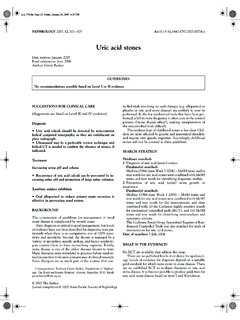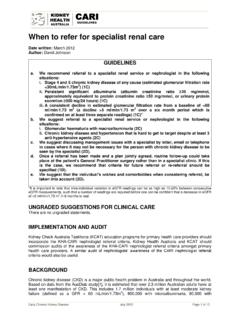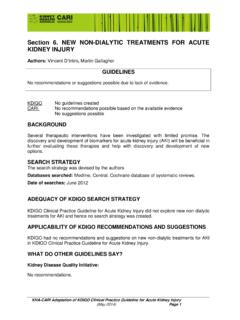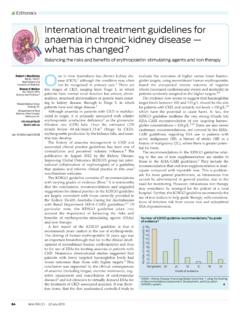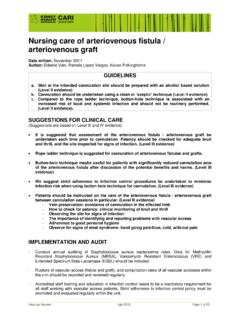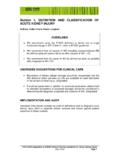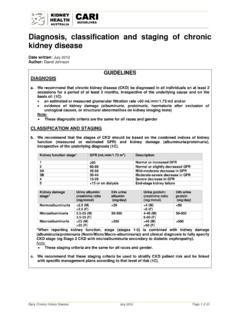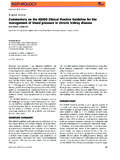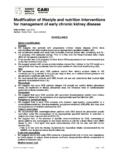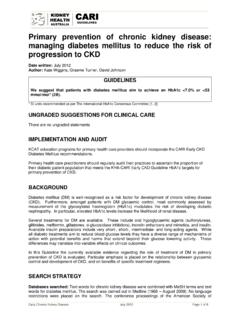Transcription of The KHA-CARI Guidelines Peritoneal dialysis catheter ...
1 The KHA-CARI Guidelines Caring for Australasians with Renal Impairment ---------------------------------------- ---------------------------------------- --------------------------------- ----------------------- Peritoneal dialysis catheter related infection: exit site and tunnel Date written: April 2013. Author: Josephine Chow GUIDELINE. No recommendations possible based on Level I or II evidence SUGGESTIONS FOR CLINICAL CARE. (Suggestions are based on Level III and IV evidence). Effective antibiotic therapy is recommended for cases of Peritoneal dialysis catheter - related infection. Either intraperitoneal or oral antibiotics may be considered. IMPLEMENTATION AND AUDIT. Primarily, audit should consist of ongoing research to continually improve and validate our ability to predict outcomes based on medical parameters. BACKGROUND. Exit site infection (ESI) has been defined as clinically apparent infection at the exit site with or without a positive culture. Included in this definition is catheter tunnel tract infection.
2 Clinical signs of infection include purulent drainage, redness, swelling, warmth and tenderness over or around the exit site. Exit site and tunnel infections are a significant cause of morbidity and are responsible for a significant proportion of patient dropout from Peritoneal dialysis . [1] The bacteria that colonise the exit site are the same as those responsible for ESIs, but are different to those that cause peritonitis. [2]. There are various stages in the development of an infected exit site, which include serous and purulent drainage, abscess formation and tunnel infection. Early identification and diagnosis of the various infection stages are vital for the initiation of prompt and effective therapy. Ultrasonography of the exit site has been used to diagnose exit site and tunnel infections. A sonolucent zone around the external cuff over 1 mm thick following treatment with a course of antibiotic treatment and also with the involvement of the proximal cuff are associated with poor clinical outcome.
3 [3]. With the ultrasonographic studies, a tunnel infection is confirmed when the subcutaneous pathway is clinically occulted. [4]. Prevention of infection is considered essential for the successful maintenance of Peritoneal dialysis (PD). Strategies to prevent or reduce the risk of infection include rigorous exit site care, catheter care and meticulous attention to the use of a clean no-touch technique for dialysis exchanges. Both antibiotic and antimicrobial agents and dressing technique play important roles in the survival of the PD catheter . The objective of this guideline was to review current evidence in the prevention and management of catheter exit site infection and tunnel infection. Peritonitis Treatment and Prophylaxis (February 2014). The KHA-CARI Guidelines Caring for Australasians with Renal Impairment ---------------------------------------- ---------------------------------------- --------------------------------- ----------------------- SEARCH STRATEGY.
4 Databases searched: MeSH terms and text words for Peritoneal dialysis were combined with MeSH terms and text words for catheter , peritonitis, exit site infection and tunnel infection. The search was carried out in Medline (1950 September Week 3, 2010). The Cochrane Renal Group Trials Register was also searched for trials not indexed in Medline. Date of searches: 15 October 2010. WHAT IS THE EVIDENCE? Evaluation of the exit site/tunnel and diagnosis of infection Twardowski et al performed 565 evaluations of healed exit sites in 56 patients. [5,6] A new classification was developed with six distinct categories of exit site appearance: acute infection, chronic infection, external cuff infection, traumatised exit, etc. The outcomes in each category were correlated with treatment measures in a 5-year longitudinal study. A cross-sectional study was conducted with 45 patients, using loupe and magnifier evaluations. Ninety-one percent (41/45) of the evaluations were in agreement.
5 Vychytil et al investigated indications and outcomes of 738 ultrasound examinations of the PD. catheter tunnel. [7] The research team concluded that tunnel ultrasonography is useful to assess whether tunnel infection is present, and the severity of involvement. By using ultrasonography, a therapeutic regimen can be evaluated and reviewed. Therapy for exit site/tunnel infection Flanigan et al reported a randomised, prospective study comparing intraperitoneal vancomycin plus oral rifampin or oral trimethoprim/ sulfamethoxazole for Gram-positive catheter infections. [8]. There were 126 recorded catheter infections resulting in a rate of episodes per patient year of exposure. The cure rate of Gram-positive catheter infections treated with vancomycin plus rifampin (86% cured) was indistinguishable from that achieved with oral trimethoprim/sulfamethoxazole (89% cured; P = ). Precautions need to be considered to retard the development of vancomycin-resistant enterococcus (VRE), if prolonged use of vancomycin is planned.
6 Plum et al in a prospective randomised study, showed the greater efficacy of the intraperitoneal (IP) application of clindamycin as a first-line antibiotic compared with the oral route for the treatment of tunnel infections. [9] The results showed no significant difference in the pericatheter fluid along the catheter at study entry, with 4 mm (median; range: 2-6 mm) in the oral group and 4. mm (range: 2-4 mm) in the IP group. The IP treatment resulted in a decrease to 0 mm (0-2 mm). after 28 days (P < ), while the diameter was still 2 mm (0-10 mm; ns) in the oral group. The disappearance of ESI also occurred earlier in the IP group (51 vs 15 days; ns). catheter removal occurred once in the IP group and twice in the oral group within 6 months of study entry. There was no difference in clinical outcomes. Disinfectant Luzar reported a multicentre RCT where adult continuous ambulatory Peritoneal dialysis (CAPD). patients were randomised to disinfect the exit site 2 3 times per week with a 20 g/L solution of povidone iodine and then cover the exit site with sterile gauze, or cleanse the exit site daily with non-disinfectant soap on sterile gauze.
7 [10] There was a reduction in the rate of ESIs with the use of povidone-iodine solution compared with the soap and water cleansing (P = ). Peritonitis Treatment and Prophylaxis (February 2014). The KHA-CARI Guidelines Caring for Australasians with Renal Impairment ---------------------------------------- ---------------------------------------- --------------------------------- ----------------------- Wilson randomised 149 adult PD patients and examined the effectiveness of standard dressing changes versus standard dressing changes plus povidone-iodine dry powder spray ( ) in the prevention of ESIs and/or peritonitis. [11] Povidone-iodine did not reduce the number of total infections, ESIs or peritonitis compared with the control group over the period of the study. Other considerations Dong et al reported a prospective observational study in Chinese CAPD patients. A total of 130. patients were examined during their PD bag exchange procedure 6 months after dialysis initiation.
8 [12] Various items were observed such as dirty nails, improper hand washing, insufficient ultraviolet radiation, not wearing a face mask, checking for bag expiration or leakage, not flushing before filling and suspected connection contamination. It was concluded from a multivariate Cox regression analysis that not wearing a face mask or cap was significantly associated with a first episode of peritonitis [HR: , 95% CI: ; P < ]. Keane et al reported a summary of treatment recommendations for ESI from a consensus panel of experts. [13] The treatment recommendations for Gram-positive purulent drainage at the exit site are 2-4 weeks of a cephalosporin or vancomycin combined with oral rifampicin in the case of persistent infection, and ciprofloxacin for the treatment of Gram-negative infections. Ibels et al conducted a survey in 1995 of 35 PD units in Australia. [1] In all units, a swab culture was obtained at the first sign of PD catheter ESI and exit site care procedures were reviewed with patients.
9 Exit site infection rates were monitored, data collated, and procedures evaluated routinely in two-thirds of units. While the antibiotics used varied, most units used vancomycin or oral flucloxacillin. catheter exit site and tunnel infections accounted for 12% and 6%, respectively, of the principal indications for removal of the Peritoneal catheter . No correlations were undertaken between practices and outcomes. Turner et al randomised 66 patients into one of three catheter groups: immobilizer, tape, or non- immobilized group. [14] The incidence of ESI over 347 patient-months was recorded. The results show no significant difference in infection rate between the three groups. While the findings of the study point to a need for a better quality immobilizer, the short duration of the study precluded any definitive conclusion being drawn. Scalamogna et al reported data on surgical intervention, such as external cuff shaving in tunnel infections. [15,2,16] Shaving the cuff as a rescue treatment was effective for almost 50% of patients with antibiotic-resistant Staphylococcus aureus ESI.
10 The catheters of the remaining patients were removed because of peritonitis associated with tunnel infection.. SUMMARY OF THE EVIDENCE. There are no randomised controlled trials comparing the different classification and evaluation systems for ESI. The International Society for Peritoneal dialysis (ISPD) has developed a simple scoring system for the signs and symptoms of PD exit site. The scoring system is easy to use and provides guidance on timing to treat immediately rather than waiting for a swab result. It also recommends that purulent discharge is an absolute indicator for antibiotic treatment. [4]. There are two randomised controlled trials that have compared antibiotic therapy treatment for exit site/tunnel infection. One study compared intraperitoneal vancomycin plus oral rifampin or oral trimethoprim/sulfamethoxazole for Gram-positive catheter infections. There was no difference with either treatment on catheter infection cure rate. The second study showed that there is greater efficacy with the intraperitoneal application of clindamycin as a first-line antibiotic compared with the oral route, for the treatment of tunnel infections.
